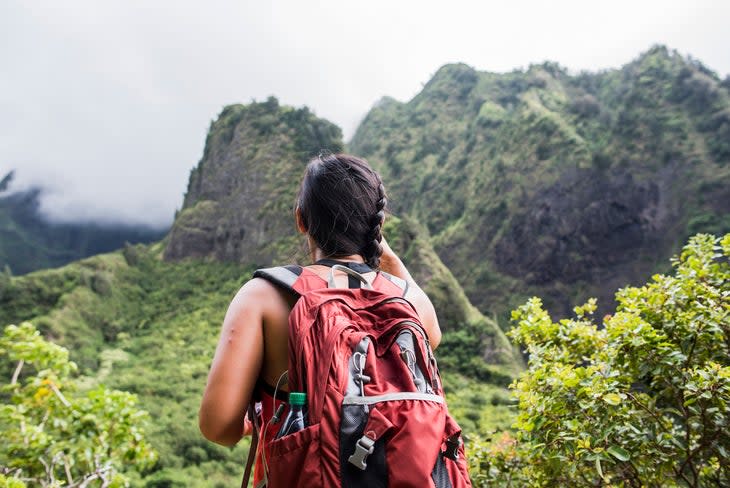Where To Hike If You Want to Avoid Bears
This article originally appeared on Backpacker
A couple of months ago, I visited Glacier National Park, planning to explore its turquoise lakes and dense forests. But if you asked my friend Andrew, I was there to get mauled by a bear.
"It's just like in The Revenant," he laughed to me afterward. I asked what he meant.
"There are bears there. And they attack people!"
My friend's doom-and-gloom perspective on hiking in bear country is out of touch with reality--bear attacks are very rare, even in bruin-dense areas--but I get where he's coming from. In San Diego, where I live, most of the bears we encounter are those Smokey cutouts that indicate the local fire danger levels that day. That's not to say that there aren't bears in Southern California, but we just don't see them nearly as frequently as we see coyotes, rattlesnakes, or seasonal wildfires.
Juicy headlines and gory scenes in movies make attacks and fatalities seem more common than they are. In reality, your chances of throwing hands against a bear are extremely low: In Yellowstone National Park, where there are over a thousand bears in the park, you have a 1 in 2.7 million chance of one injuring you, according to the National Parks Service. If you're equipped with the knowledge and essential gear, you'll be well protected in bear country. Still, though, there are good reasons to avoid hiking in bear country: Maybe you don't want to deal with the hassle of carrying a canister or hanging a bag, for example.
Finding hikes where you're guaranteed not to see a bear, however, can be tougher than you'd think. Google places without bears, and the algorithm will just send you pages of guides to find and observe the ursine in its natural habitat. But fear not: There are plenty of regions, parks, and states in the country that are either bear-free or have very few bears.

Hawaii
If you want a guaranteed hike without bears, Hawaii is the state for you. There aren't any bears in the state, and there are plenty of verdant trails to explore. You'll be able to explore the volcanic landscape, cliffside views, and diverse microclimates without worrying about one raiding your pack. Browse our favorite Hawaii hikes here. The island has limited resources and a fragile ecosystem, and you can be a respectful visitor by leaving no trace on the trails, wearing reef-safe sunscreen, and packing out whatever wrappers or trash you have.
Central USA
There are many reasons you shouldn't skip flyover country, and its low bear population is just one of them. North and South Dakota, Nebraska, Kansas, Iowa, Illinois, Indiana, Ohio, Oklahoma, central and northern Missouri, and central and eastern Texas all have few to no bears (though not necessarily zero). See the same vistas that greeted Lewis and Clark in this Kansas hike.
Isle Royale National Park
You can leave your bear canisters at home when you're visiting this Lake Superior island. Set in the northernmost stretches of Michigan, this park's apex predators are wolves, and the largest mammals are moose. This island is just over 200 square miles, but it's jam-packed with remote trails, evergreen forests, and stunning lakefront views. Want to thru-hike across the entire island? Check out the classic Greenstone Ridge Trail. This 40-mile trek takes you from one shoreline to another through trails lined with dense pine trees, thick ferns, and thimbleberry bushes that yield perfectly ripe fruit in the late summer.
Florida
Yes, there are bears in Florida (and they're not just the animatronic ones singing to you in Disney World's Splash Mountain). Before Europeans settled in Florida, black bears occupied the entire mainland, but now they're in just under half of the state. You can avoid them in central and southern portions of Florida. Another option: get in the water. There are no bears in Dry Tortugas National Park, though there are West Indian manatees, which we've scientifically determined are some of the cutest animals in national parks around the country.
Death Valley National Park and Joshua Tree National Park
For a state with a bear on its flag, California has lots of bear-free regions and national parks. In Joshua Tree, you have a better chance of spotting a UFO than an ursine. They're very uncommon in this national park--occasional area visitors but not regular residents. In Death Valley, it's not so much the wildlife you should protect yourself from, it's the heat: It's the lowest, hottest, and driest spot in the country, after all. The best times to visit are November through March because temperatures are consistently above 100degF in the summer. Joshua Tree doesn't trail too far behind, with average summer temperatures in the high 90s. The best times to visit are from March to May and October to November. These two parks are a four-hour drive apart; you can visit them both on a bear-free trip through Southern California. Check out these epic Death Valley and Joshua Tree hikes.
For exclusive access to all of our fitness, gear, adventure, and travel stories, plus discounts on trips, events, and gear, sign up for Outside+ today.